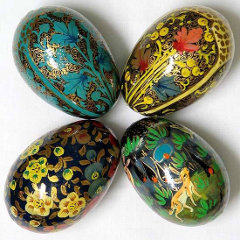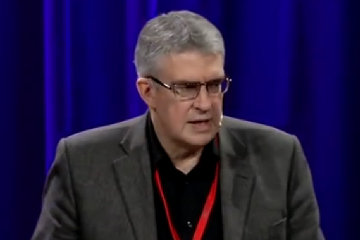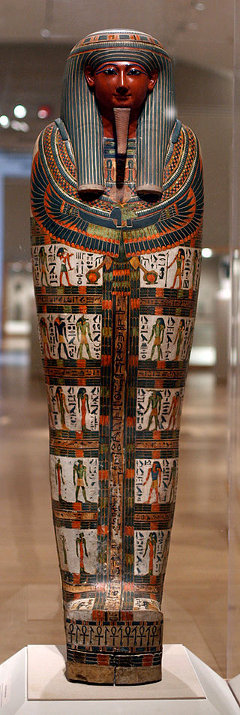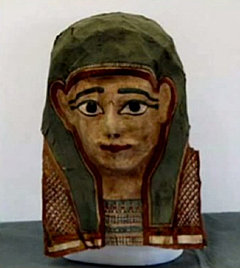Scholarship or Vandalism?
Many years ago, in Kashmir, we were induced to visit a papier mâché factory. The word "factory", in tourist circumstances, is a misnomer. The establishment in question was simply a large and slightly seedy salesroom in which numerous objects made of papier mâché were on display and salesmen hovered round eager to persuade you to purchase things which could be bought for half the price from the even grubbier vendors who clustered round the doors of hotels, restaurants, rest rooms and tourist offices.

| |
| Four beautiful papier mâché eggs from Kashmir. |
In later years we were to discover carpet factories, perfume factories, alabaster factories, papyrus factories and - I kid you not - a diamond factory. I suppose the misnomer comes from an out-of-date dictionary listing "factor" as "agent" and "factory" as "a trading station maintained by factors in a foreign country".
Anyway, enough of such etymological speculations. While my parents fended off the salesmen, I wandered round this factory entranced by the gaudy colours - primal blues, carmine reds, bilious yellows, tropical greens, picked out and enhanced by touches of gold leaf (which I now suspect was some variety of alumnium foil) - all arranged in oriental patterns that bewildered the eye and seduced the senses. The other thing I remember was the astonishing lightness of the objects. A large box, jewellery, for the keeping of, was as light as a feather and an ornate egg seemed as if a puff of wind would carry it away.
Of course, it isn't just Kashmiris who make papier mâché. The whole business loses some of its appeal when you turn to the dictionary and discover that the words are French for "chewed paper"! It conjures up delightful images of Madame Defarge suspending her knitting while she masticates her way through a pile of discarded telephone directories.
Even the French, however, cannot claim to have invented the process. Historians are tolerably confident that they know the culprits: the Egyptians. It cannot have been the Sumerians or the Hittites or any other possible contenders because those civilisations did not invent paper - and you can't make a decent papier mâché out of chewed up clay tablets! The Egyptians, on the other hand, did have the original paper, made out of papyrus.

| |
| The villain of the piece - Craig Evans. |
One of the characteristics of papier mâché is that the manufacturers economise by not using sheets of brand new paper for their product. They are, I suppose, the original recyclers. The few essays at papier mâché making I have undertaken (with my sons when they were small, you understand) involved torn up newspapers and considerable quantities of wall-paper paste.
The ancient Egyptians were similarly parsimonious - or ecology minded, if you prefer - and also used strips of discarded papyrus to produce papier mâché. The objects they made were not jewellery cases or ornamental eggs, but mummy masks. Wood was expensive, stone too heavy, but papier mâché was cheap, easy to work with, and the skillful practitioner could produce a satisfactory likeness of the dear departed cheaply and easily. A coat of paint, a touch of gold leaf, and waste papyrus could be turned into something worth a lot of money. I believe the modern term is "added value".

| |
| A beautiful cartonnage mummy case from the Brooklyn Museum. We have to hope that Craig Evans never gets his hands on it. |
The trouble lies in that term "waste papyrus". The discarded sheets could be unwanted tax returns or worn out copies of Euclid or, in the case which inspired this article, copies of the Gospel of Mark.
Acadia Divinity College in Wolfville, Nova Scotia, was given an ancient Egyptian mummy mask made of cartonnage - the technical term for Egyptian papier mâché. No doubt the doner expected that his gift would be accorded pride of place in a college museum of Biblical history or a resource centre or some such thing. Instead of which, the thing was handed over to the department of New Testament Studies who promptly set to work to destroy it.
Craig Evans, professor of New Testament Studies, proudly boasted, "We're recovering ancient documents from the first, second and third centuries." Among these ancient documents are fragments of the Gospel of Mark.
Now it is undoubtedly a good thing to have ancient documents and it is certainly true that damaged cartonnage has yielded up not only business papers, personal letters, long-lost plays by Greek authors, poetry by Homer and so on. On the other hand, there are sufficient third century copies of the Gospel of Mark that we are not in desperate need of another one and certainly not at the price of destroying a perfectly good mummy mask.
Certainly the archaeological world has been outraged by the actions of the theologians. Paul Barford wrote in a blog, "Getting the mask off the wrapping was usually accompanied by the destruction of the whole mummy. Now these guys with their atrocious accents and patronising attitudes are destroying what's left to get their hands on trophy exhibits," Robert Mazza, lecturer in Classics and Ancient History at the University of Manchester agrees, lamenting that the actions of Mr Evans are "not only misinformed, but can even encourage more people to buy mummy masks on the antiquities market and dissolve them in Palmolive soap."
Mr Evans defends himself by claiming that the mask was "not of museum quality", but in the first place what exactly is "museum quality"? and in the second place, is a professor of New Testament Studies the right person to pass judgements on Egyptian artefacts?

| |
| The rather ugly - and therefore unique and valuable - mummy mask destroyed by Craig Evans. |
The tragedy is that this theologian, in his ignorance, is ignoring the fact that in a few years time techniques may be invented that will enable us to read the papyrus in the cartonnage without destroying the mask! We bitterly regret the fact that so many royal mummies were opened - with the best of intentions, I am sure - by early Egyptologists who destroyed goodness knows what treasures of knowledge in their zeal to discover what lay within. Nowdays such a mummy would be left intact but investigated by x-rays and CT scans and still be in existence for further investigation in a hundred years time by means and methods still undreamed of.
Craig Evans may be able to tell you the exact significance of the alternate spelling of the third word in the second paragraph of Mark's gospel, but outside that specialised field he is clearly so ignorant that he is a danger to real scholarship and a menace to learning. His motivation may be different, but his actions are the equivalent of the ISIS vandals in Mosul and elsewhere. Let him stick to his New Testament studies and leave Egyptian mummy masks alone.
Madame Defarge A blood-thirsty character in Dicken's Tale of Two Cities famous for knitting at the foot of the guillotine. The purpose of this sinister knitting is never made entirely clear. Return
cartonnage Cartonnage could be of used linen or papyrus, glued together with plaster and given a finishing coat of plaster to provide the smooth surface required to paint the face or write a chapter or two of the Book of the Dead. Return
© Kendall K. Down 2015





